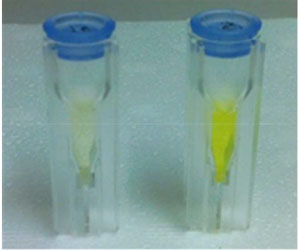 UK researchers have developed a faster way to detect Staphylococcus aureus bacteria using a fluorescent probe. The method holds promise as the basis for a new rapid diagnosis kit to identify infections in hospital patients.
UK researchers have developed a faster way to detect Staphylococcus aureus bacteria using a fluorescent probe. The method holds promise as the basis for a new rapid diagnosis kit to identify infections in hospital patients.
S. aureus infections, including both methicillin-resistant and methicillin-susceptible strains (named MRSA and MSSA, respectively), persist in hospital wards worldwide. In the UK, controlling outbreaks is a constant challenge for the NHS. Fast diagnosis is as important as thorough treatment in the early stages of an outbreak. However, current screening methods are slow and costly.
‘The problem with existing techniques is that they take time,’ explains Adam Le Gresley, of Kingston University, who lead the team that developed the probe. ‘You either have to amplify the bacteria in culture, or amplify the DNA with PCR. It’s not something that can be done at the point of care.’
To address this, Le Gresley and his colleagues have developed a test that is sensitive to very low levels of bacteria, eliminating the need for culture. The method utilises staphylothrombin, an enzyme complex unique to S. aureus. It employs a test solution comprising a tripeptide chain, which mimicks staphylothrombin’s natural target, that is bound to rhodamine, a fluorescent dye. When S. aureus is present, it releases staphylothrombin which frees the rhodamine from the tripeptide by cleaving an amide bond. This results in a strong colouration in the solution.
Read the full story in Chemistry World
Development of an in situ culture-free screening test for the rapid detection of Staphylococcus aureus within healthcare environments
Alex Sinclair, Lauren E. Mulcahy, Lynsey Geldeard, Samerah Malik, Mark D. Fielder and Adam Le Gresley
DOI: 10.1039/c3ob40150b










